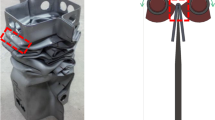Abstract
Many automotive body structure components are made of press-hardened steel (PHS) to ensure occupant safety, and they are often subjected to bending-dominated deformation such as axial folding and side intrusion and fracture usually occurs under plane strain bending. Therefore, fracture strain under plane strain condition is an important material property for designing mass-efficient components while maintaining vehicle crashworthiness. The VDA 238-100 standard uses bending angle to qualitatively assess fracture resistance of PHS. However, bending angle is thickness dependent and it cannot be utilized in finite element models to characterize materials’ fracture limit for predicting structure failure. In this study, a methodology to determine fracture strain of PHS is developed by applying interrupted bending tests and extrapolation, without using any direct strain measurement system. Then this method is applied to determine fracture strains of bare and AlSi-coated PHS with various thicknesses and prior austenite grain sizes, and the results are compared to that obtained from direct strain measurements. An error analysis is also performed to assess factors/assumptions affecting the accuracy of the proposed methodology. The new method is easy to implement and can be broadly applied to determine fracture strain for other sheet metals whose bendability was previously evaluated by VDA bending angle.












Similar content being viewed by others
References
A. Barcellona and D. Palmeri: Metall. Mater. Trans. A, 2009, vol. 40A, pp. 1160-74.
K. Mori, P.F. Bariani, B.A. Behrens, A. Brosius, S. Bruschi, T. Maeno, M. Merklein, and J. Yanagimoto: CIRP Ann. Manuf. Technol., 2017, vol. 66, pp. 755-77.
P. Larour, H. Pauli, T. Kurz, and T. Hebesberger: 29th IDDRG Conf. Tools Technol. Process. Ultra High Strength Steels, 2010, pp. 27–36.
K. Cheong, C. Butcher, and J. Dykeman: SAE Int. J. Mater. Manuf., 2018, vol. 11, pp. 541-52.
C. Iacono, J. Sinke, and R. Benedictus: J. Manuf. Sci. Eng., 2010, vol. 132, pp. 237-47.
J. Datsko and C.T. Yang: J. Eng. Ind., 1960, vol. 82, pp. 309-14.
T.C. Chu, W.F. Ranson, M.A. Sutton, and W.H. Peters: Exp. Mech., 1985, vol. 25, pp. 232-44.
E. Shaprio: in ASM Handbook of Mechanical Testing and Evaluation, 10th ed., ASM International, Materials Park, OH, 2000, pp. 422-36.
C.T. Wang, G. Kinzel, and T. Altan: J. Mater. Process Technol., 1993, vol. 39, pp. 279-304.
H. Kim, N. Nargundkar, and T. Altan: J. Manuf. Sci. Eng., 2007, vol. 129, pp. 342-51.
P. Larour, B. Hackl, and F. Leomann: 32nd IDDRG Conf. Tools Technol. Process. Ultra High Strength Steels, 2013, pp. 317–22.
C.M. Enloe, J. Wang, J.P. Singh, C. Horvath, N. Ramisetti, and S. Sriram: Iron Steel Technol., 2016, vol. 13, pp. 124-33.
L.Golem, L. Cho, J.G. Speer, and K.O. Findley: Mater. Des., 2019, vol. 172, 107707.
C. Liu, J.C. Pang, W. Xu, H.L. Yi, Q. Lu, and J. Wang: 7th Int. Conf. Hot Sheet Met. Form. High-Perform. Steel, 2019, pp. 509–18.
J. Wang, C. Enloe, J. Singh, and C. Horvath: SAE Int. J. Mater. Manuf., 2016, vol. 9, pp. 488-93.
P. Larour, J. Naito, A. Pichler, T. Kurz, and T. Murakami: 5th Int. Conf. Hot Sheet Met. Form. High-Perform. Steel, 2015, pp. 281–90.
P. Dietsch, K. Tihay, S. Cobo, S. Sarkar, D. Hasenpouth, and D. Cornette: 6th Int. Conf. Hot Sheet Met. Form. High-Perform. Steel, 2017, pp. 629–38.
L. Cho, D.H. Sulistiyo, E.J. Seo, K.R. Jo, S.W. Kim, J.K. Oh, Y.R. Cho, and B.C. De Cooman: Mater. Sci. Eng. A, 2018, vol. 734, pp. 416-26.
Z. Wang, Z.H. Cao, J.F. Wang, and M.X. Huang: Scripta Mater., 2021, vol. 192, pp. 19-25.
Acknowledgments
This research was financially supported by the National Natural Science Foundation of China (Grant Nos. 51722402 and U1560204) and the Fundamental Research Funds for the Central Universities (Grant No. N170705001).
Author information
Authors and Affiliations
Corresponding authors
Additional information
Publisher's Note
Springer Nature remains neutral with regard to jurisdictional claims in published maps and institutional affiliations.
Manuscript submitted June 22, 2020; accepted November 5, 2020.
Rights and permissions
About this article
Cite this article
Cai, H.L., Wang, J.F., Wu, D. et al. A Simple Methodology to Determine Fracture Strain of Press-Hardened Steels Under Plane Strain Bending. Metall Mater Trans A 52, 644–654 (2021). https://doi.org/10.1007/s11661-020-06103-6
Received:
Accepted:
Published:
Issue Date:
DOI: https://doi.org/10.1007/s11661-020-06103-6




